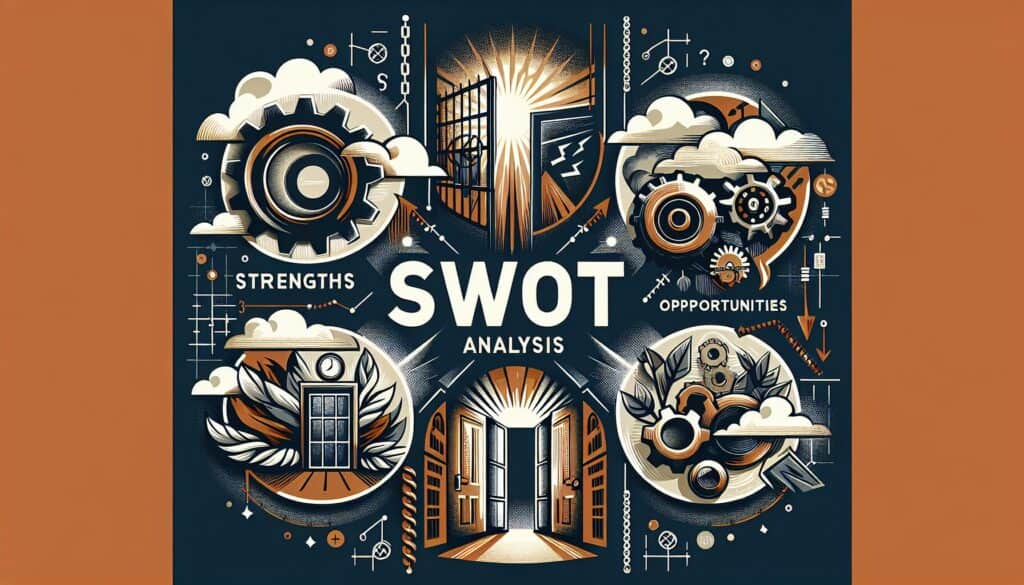To evaluate an organization’s, project’s, or individual’s Strengths, Weaknesses, Opportunities, and Threats to inform strategic planning.
- Metodologías: Clientes y marketing, Ideación, Diseño de producto
Análisis DAFO

Análisis DAFO
- Reingeniería de procesos empresariales (BPR), Análisis competitivo, Innovación, Estudios de mercado, Gestión de proyectos, Gestión de riesgos, DAFO, Análisis DAFO
Objetivo:
Cómo se utiliza:
- Strengths (internal, positive attributes), Weaknesses (internal, negative attributes), Opportunities (external, factors that can be exploited), and Threats (external, factors that could cause trouble) are identified and listed, often in a four-quadrant matrix.
Ventajas
- Simple framework for organizing strategic thinking; Helps identify key internal and external factors; Facilitates discussion and consensus building; Can be applied broadly at different levels.
Contras
- Can be subjective and based on opinions rather than data; May generate long lists without clear prioritization; Does not inherently offer solutions or actions; Static and may quickly become outdated.
Categorías:
- Clientes y marketing, Economía, Ideación, Gestión de proyectos
Ideal para:
- Strategic planning, business planning, competitor analysis, and assessing the viability of new initiatives.
DAFO Analysis finds extensive applicability across various sectors including technology, healthcare, manufacturing, and consumer services, often employed during the early stages of project development or strategic planning sessions to evaluate the potential of new product ideas or market entries. Teams made up of product designers, engineers, marketing professionals, and business strategists frequently initiate the SWOT process, allowing for diverse perspectives that can enrich the output of the analysis. In industries such as healthcare, for instance, this method is particularly useful when launching innovative medical devices where understanding both the internal capacities of the organization and the external demands of regulatory compliance and market needs is paramount. The simplicity of the matrix encourages brainstorming sessions that not only identify strengths and weaknesses but also stimulate discourse around how to leverage untapped opportunities—such as emerging technologies or shifting consumer preferences—and mitigate potential threats, including competitive pressures or economic downturns. Organizations can engage in SWOT Analysis at various levels, from a high-level assessment of company strategy to a focused analysis of specific products or initiatives, allowing for flexibility in its application. As a strategic planning tool, it promotes alignment among stakeholders, driving consensus on priorities and enabling teams to formulate actionable plans based on a structured evaluation of both internal capabilities and external market dynamics.
Pasos clave de esta metodología
- Identify and list internal strengths relevant to the product or initiative.
- Identify and list internal weaknesses that could hinder progress.
- Identify and list external opportunities that can be leveraged.
- Identify and list external threats that could pose risks.
- Analyze the relationships between internal strengths and external opportunities.
- Evaluate how internal weaknesses can be mitigated by addressing external threats.
- Develop strategic initiatives based on the analysis of the SWOT matrix.
Consejos profesionales
- Integrate quantitative data analysis with qualitative observations to enhance the reliability of the SWOT findings.
- Regularly update the SWOT matrix to reflect changes in the market landscape and internal capabilities, fostering agility in strategic responses.
- Involve cross-functional teams in the SWOT analysis process to uncover diverse perspectives and reduce blind spots in assessment.
Leer y comparar varias metodologías, recomendamos el
> Amplio repositorio de metodologías <
junto con otras más de 400 metodologías.
Sus comentarios sobre esta metodología o información adicional son bienvenidos en la dirección sección de comentarios ↓ , así como cualquier idea o enlace relacionado con la ingeniería.
Contexto histórico
1960
1980
1983
1990
1995
2000
2010
1950
1980
1980
1986
1994
1995
2000
(si se desconoce la fecha o no es relevante, por ejemplo "mecánica de fluidos", se ofrece una estimación redondeada de su notable aparición)














Publicaciones relacionadas
Cuestionarios sobre molestias musculoesqueléticas
Pruebas multivariantes (MVT)
Análisis de regresión múltiple
Sistemas de captura de movimiento
Método MoSCoW
Prueba de la mediana de Mood